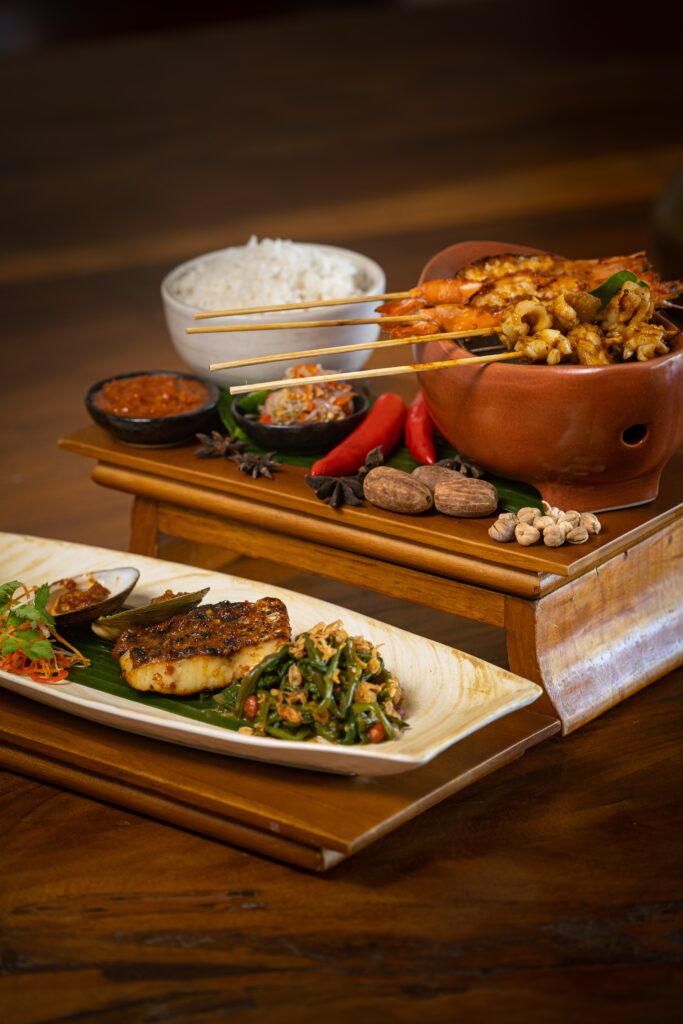Exploring authentic Balinese dishes offers a delicious journey beyond the familiar Nasi Goreng, revealing the unique culinary heart of the Island of the Gods. While staples like fried rice and noodles provide a comforting introduction to Indonesian flavors, Bali boasts a distinct and fascinating culinary landscape all its own. Indeed, Balinese cuisine is deeply intertwined with its unique culture and spirituality. As your friendly guides here at Merusaka, we invite you to venture beyond the usual with us. Let’s discover some truly special flavors that will tantalize your taste buds and give you a deeper appreciation for the island’s heritage. In this guide, we’ll explore some must-try specialties. Importantly, we’ll also chat about how to navigate your culinary adventures safely and confidently, addressing that common concern known as “Bali Belly,” including how to handle the local love for chili!
Ready to explore the delicious heart of Bali?
The Soul of Balinese Cooking: Spices, Freshness & Harmony
Understanding the foundation of Balinese cuisine helps appreciate its uniqueness before we talk specific dishes.
-
The Mighty Spice Paste (Base Genep / Bumbu Bali) This complex paste is the cornerstone of countless Balinese recipes. Unlike simpler flavor profiles you might find elsewhere, Base Genep is an aromatic blend. Cooks traditionally pound or blend it from a potent mix of ingredients. These typically include galangal, turmeric, ginger, lesser galangal (kencur), shallots, garlic, chili peppers, lemongrass, salam leaves (Indonesian bay leaves), candlenuts, coriander seeds, black pepper, and often shrimp paste (terasi). Consequently, this often results in dishes with a noticeable, vibrant heat that’s characteristic of the cuisine. Ultimately, this rich bumbu provides an incredible depth and layered flavor, defining many Balinese dishes.
-
Emphasis on Fresh & Local Bali’s fertile volcanic soil yields an abundance of fresh vegetables, fruits, and herbs. For instance, you’ll notice ingredients like fragrant lime leaves, turmeric leaves, and chilies featuring prominently. Additionally, the island’s proximity to the sea also means fresh seafood is common. This appears alongside poultry (chicken and duck) and pork, which holds particular ceremonial significance in Balinese culture.
-
Food as Connection In Bali, food represents more than just sustenance; rather, it’s integral to family life, community gatherings, and religious ceremonies. Families prepare elaborate feasts for temple festivals (odalan) and life-cycle rites. This clearly reflects the Balinese philosophy of Tri Hita Karana – maintaining harmony with God, fellow humans, and nature . Indeed, sharing food forms a key part of these vital connections.
-
A Symphony of Flavors Prepare for a delightful interplay of tastes in Balinese food. Specifically, you’ll experience the heat of chili, the sourness of tamarind or lime, the sweetness of palm sugar, the savory depth of spices and shrimp paste, and the freshness of various herbs. All these elements work together, thus creating complex and harmonious flavors.
Your Culinary Bucket List: Must-Try Balinese Dishes & Experiences
Now, let’s get specific! Here are some authentic Balinese dishes and a unique dining experience worth seeking out during your visit:
1. Babi Guling (Balinese Suckling Pig)
- The Dish: This is perhaps Bali’s most famous ceremonial dish. Expert cooks stuff and marinate a whole pig with a rich Base Genep spice mix.
- The Roasting Ritual: They then laboriously spit-roast it over coconut husks or wood fire for hours. Consequently, the process results in incredibly crispy skin and succulent, flavorful meat.
- Flavor Profile: Imagine crispy, crackling skin giving way to tender, richly spiced pork underneath. It’s truly a textural and flavorful delight.
- Serving Suggestions: Cooks often serve Babi Guling with lawar (see below), steamed rice, and perhaps some spicy sambal (chili sauce). This combination offers a complete plate of varied tastes and textures.
- Cultural Context: Balinese traditionally prepare Babi Guling for major ceremonies and celebrations, like weddings or temple festivals, where it symbolizes communal feasting. Nowadays, however, it’s also widely available for daily enjoyment.
- Where to Find It: Look for specialized warungs (local eateries) displaying “Babi Guling” signs. Popular spots often sell out by early afternoon, so visiting earlier is recommended. Finding truly exceptional Babi Guling often becomes a dedicated quest due to its cultural significance!
2. Ayam or Bebek Betutu (Slow-Cooked Chicken or Duck)
- The Dish: Cooks rub and stuff a whole chicken (Ayam) or duck (Bebek) with the aromatic Base Genep spice paste. They traditionally wrap it tightly in banana leaves or palm bark.
- The Slow-Cooking Secret: Then, it’s slow-cooked for many hours, often in embers underground or steamed/roasted until incredibly tender. This long cooking process allows the rich spices to deeply penetrate the meat, thus making it exceptionally moist and flavorful.
- Flavor Profile: Expect intensely aromatic and flavorful notes. The meat literally falls off the bone. Furthermore, it’s savory, complex, and utterly delicious, often carrying a noticeable spicy warmth.
- Cultural Context: This dish is also often associated with special occasions. However, you can now find it in many restaurants specializing in Balinese cuisine.
- Where to Find It: Seek out restaurants known for Balinese specialties. Some establishments may require pre-ordering due to the lengthy cooking time. Additionally, you might find refined versions gracing the menus of sophisticated resort restaurants.
3. Sate Lilit (Minced Meat Satay)
- The Dish: This satay differs uniquely from the chunkier meat versions found elsewhere. Balinese chefs make Sate Lilit from minced meat, often fish (ikan), but also chicken, pork, or beef. They mix it thoroughly with grated coconut, coconut milk, and a fragrant bumbu spice blend.
- Preparation: This mixture is then carefully “wrapped” or “lilit” around skewers. Traditionally, these are flat sticks of bamboo, sugarcane, or even fragrant lemongrass stalks. Grilling over charcoal adds a lovely smokiness.
- Flavor Profile: It’s tender, moist, and packed with flavor. The minced texture is unique. Moreover, the spices combined with the coconut create a slightly sweet, savory, and aromatic taste, usually with a mild to moderate background heat. Using lemongrass skewers imparts an extra layer of delightful fragrance.
- Cultural Context: Sate Lilit is a popular offering during ceremonies. It’s also enjoyed as a common everyday snack or side dish.
- Where to Find It: It’s widely available in local warungs and restaurants. You might also find it grilled fresh at night markets or during ceremonies.
4. Lawar (Minced Meat & Vegetable Salad with Coconut)
- The Dish: Lawar is a quintessential Balinese ceremonial dish. Indeed, it’s a complex mixture that showcases Balinese culinary artistry.
- Understanding the Ingredients: It typically features minced meat (often pork or chicken), finely chopped vegetables (like green beans or young jackfruit), grated coconut, and a rich blend of spices (Base Genep).
- Red vs. White Lawar: Traditionally, cooks sometimes add fresh animal blood for color and flavor, creating Lawar Merah (Red Lawar). Versions without blood are called Lawar Putih (White Lawar). We mention the traditional inclusion of blood for cultural context, but many versions served, especially to visitors, may be the white variety (Lawar Putih).
- Flavor Profile: The taste varies greatly depending on the specific ingredients used. However, Lawar is generally savory, spicy, rich, and textural. You get a unique mix from the minced meat, crunchy vegetables, and coconut. It offers an intense flavor experience and is often quite spicy.
- Cultural Importance: Lawar is an indispensable part of Balinese feasts and ceremonies. Community members often prepare it together. Furthermore, different villages might even have their own special variations.
- Where to Find It: You’ll most commonly find Lawar as part of ceremonial meals or at eateries specializing in traditional Balinese fare, often alongside Babi Guling. Restaurants catering to visitors might more commonly offer White Lawar versions.
5. Sayur Urab (Balinese Mixed Vegetable Salad)
- The Dish: This is a refreshing and healthy Balinese side dish. It consists of various blanched or steamed vegetables, such as long beans, spinach, bean sprouts, and cabbage.
- Preparation: Cooks toss these vegetables with a flavorful seasoned and toasted grated coconut mixture. This mixture is often spiced with chili, garlic, kencur (lesser galangal), and lime.
- Flavor Profile: Expect fresh, slightly crunchy vegetables coated in savory, spicy (usually mild to moderate), and fragrant toasted coconut. Consequently, it offers a lovely textural and flavor contrast, especially alongside richer main dishes.
- Cultural Context: Sayur Urab commonly accompanies many Balinese meals, both for daily consumption and during ceremonies.
- Where to Find It: It’s widely available in most restaurants and warungs serving Balinese or Indonesian food.
6. Tipat Cantok (Rice Cakes with Peanut Sauce)
- The Dish: While it might resemble the Indonesian Gado-Gado, Tipat Cantok is a distinct Balinese version. It features tipat – compressed rice cakes cooked skillfully in woven young palm leaves. Cooks mix these rice cakes with vegetables (like water spinach, bean sprouts), tofu, and sometimes tempeh.
- The Sauce: Everything is then coated in a freshly ground peanut sauce (bumbu kacang). Importantly, the Balinese peanut sauce often has its own character, sometimes using fragrant lime or different spice balances compared to other regions.
- Flavor Profile: Enjoy savory, slightly sweet, nutty peanut sauce coating tender rice cakes and fresh vegetables. It’s typically mild unless you request or add extra sambal (chili sauce). Overall, it makes for a satisfying and popular light meal or snack.
- Cultural Context: This is a common everyday dish enjoyed throughout Bali by locals.
- Where to Find It: You can find Tipat Cantok easily at local eateries (warungs), street food stalls, and sometimes in casual restaurants.
7. Jimbaran-Style Grilled Seafood (An Experience)

- The Concept: This is less a specific recipe and more an iconic Bali dining experience. Along the shores of Jimbaran Bay (just a pleasant drive from Nusa Dua), numerous beachfront cafes specialize in grilling incredibly fresh seafood over fragrant coconut husks.
- Selecting Your Catch: The unique appeal usually involves selecting your own fresh seafood. Choices often include various fish, prawns, lobster, clams, and squid, typically displayed appealingly on ice. You pay by weight. Then, the cafe chefs grill your selection simply but perfectly, often basting it with garlic butter or mild chili sauces.
- The Beachfront Experience: The real magic truly lies in the ambiance. Most cafes set up tables directly on the sand. Arrive before sunset, find a table, order your seafood, and watch the sun dip below the horizon over the calm bay – it’s incredibly atmospheric. As dusk turns to night, the beach often twinkles with candlelight from the tables.
- Flavor Profile: The star here is undeniably the freshness of the seafood. This is enhanced by the smoky char from the coconut husk grill. Flavors are generally simple, allowing the quality of the seafood to shine. Your meal is typically complemented by steamed rice, perhaps some stir-fried kangkung (water spinach), and crucially, an array of Balinese sambals offered on the side, allowing you to add heat to your liking.
- Cultural Context: While not a traditional ceremonial dish, the Jimbaran dinner has become famous as a quintessential Bali visitor experience. It highlights the island’s connection to the sea and offers a memorable way to enjoy a meal in a spectacular setting.
- Where to Find It: Exclusively at the cluster of seafood cafes along the beach in Jimbaran Bay. It’s very popular, especially around sunset, so expect it to be busy. Our concierge team can offer recommendations for reputable cafes or help arrange transpor.
Exploring these dishes and experiences offers a true taste of Bali’s culinary heritage!
Navigating Your Culinary Journey Safely: Avoiding “Bali Belly”
Now, let’s address a common concern for travelers everywhere: traveler’s diarrhea, sometimes nicknamed “Bali Belly.” While it’s something to be aware of, please don’t let potential worries deter you from enjoying Bali’s incredible food scene! By taking some simple precautions and making mindful choices, you can savor the flavors safely and confidently.

Understanding the Cause (It’s Not Usually About ‘Dirtiness’) Firstly, understand that “Bali Belly” typically occurs when your digestive system encounters bacteria, viruses, or parasites that it’s not used to. This often happens through consuming contaminated food or water. This risk exists anywhere in the world when traveling. It’s generally less about the inherent cleanliness of a place and more about your body adjusting to a different environment and microorganisms.
Practical Tips for Safe and Happy Eating:
Here’s how you can be adventurous with your palate while minimizing risks:
- Tip 1: Water Safety is Paramount: This is perhaps the most crucial advice. Drink only bottled, boiled, or reliably filtered water. Avoid drinking tap water directly. Additionally, using bottled water for brushing your teeth is wise, especially if you have a sensitive stomach. Be mindful of ice in drinks. In reputable hotels (like Merusaka) and established restaurants, ice is almost always made from purified water and is safe. However, if you’re unsure at a smaller establishment or street stall, it’s perfectly okay to ask for drinks without ice (“tanpa es”).
- Tip 2: Smart Food Choices:
- Opt for food that is cooked fresh and served piping hot, as high temperatures kill most harmful bacteria.
- Be cautious with raw salads or fruits that you haven’t peeled yourself, particularly from smaller stalls where water sources might be uncertain. Thorough washing with safe water is key. Salads served in established restaurants and hotels are generally prepared using safe practices.
- Street food can be a wonderful part of the experience! For instance, choose vendors who are busy (indicating high turnover and freshness), look clean, and cook food right in front of you. If trying specialties like Babi Guling, opt for well-known, popular warungs recommended by locals or reliable guides.
- Tip 3: Hand Hygiene Habits: Wash your hands thoroughly with soap and water before eating. Furthermore, carrying an alcohol-based hand sanitizer is very convenient for times when soap and water aren’t readily available.
- Tip 4: Gradual Introduction (Especially with Spice!): Balinese food is renowned for its bold flavors. That often includes a generous amount of chili heat! Consequently, many authentic dishes pack a noticeable punch. If you’re not accustomed to very spicy food, it’s definitely wise to approach it cautiously. This is particularly true during your first few days on the island. Give your palate and digestive system time to adapt before diving into the spiciest options. Therefore, don’t jump straight from mild home cooking into the most fiery sambal matah (raw chili relish) or the most intensely spiced Betutu!
- Communicating Spice Levels: When ordering, you can always politely ask if a dish is pedas (peh-dahs), which means spicy. If you’d prefer less heat, you can try requesting it tidak pedas (tee-dak peh-dahs) meaning ‘not spicy’, or kurang pedas (koo-rahng peh-dahs) for ‘less spicy’. While dishes made with pre-prepared spice pastes might not always be adjustable, it’s often worth asking, especially for freshly prepared items. Moreover, starting with smaller portions or dishes known to be milder is also a good strategy. This allows you to gradually build up your tolerance if you wish to explore Bali’s spicier culinary side later in your trip.
- Tip 5: Trust Your Instincts: If a place doesn’t look or smell clean, or if food looks like it’s been sitting out for a long time, it’s usually best to choose somewhere else. Your intuition is often a good guide.
- Stay Hydrated: Remember to drink plenty of safe water throughout the day. Staying well-hydrated helps maintain overall health and can aid digestion.
Helpful Preparations & Remedies:
- Packing for Preparedness: Consider packing basic medications. Include anti-diarrheal medication (like Loperamide) for symptomatic relief if needed. Also, pack oral rehydration salts (ORS) to replenish fluids and electrolytes if you do experience an upset stomach. Of course, know the appropriate usage for these items.
- Consider Probiotics: Some travelers find taking probiotic supplements for a week or two before and during their trip helps support their gut health. As always, it’s best to discuss this with your doctor first for personalized advice.
A Reassuring Note: Please remember, the vast majority of visitors enjoy Bali’s diverse culinary offerings without any significant issues! By simply being mindful, making sensible choices, and practicing good hygiene, you can confidently explore the delicious world of Balinese food. Here at Merusaka, we adhere to stringent international food safety standards in all our dining venues. This ensures you can savor both local and international cuisine with complete peace of mind.
Your Balinese Culinary Adventure Awaits!
We hope this guide has truly whetted your appetite! We certainly encourage you to explore the authentic, vibrant flavors of Balinese cuisine that lie beyond the familiar favorites. From the ceremonial richness of Babi Guling to the aromatic tenderness of Ayam Betutu, the fresh zest of Sayur Urab, and the atmospheric delight of a Jimbaran seafood feast, there’s a whole world of taste sensations waiting for you here.
Remember that food in Bali connects deeply to its culture and community. Therefore, trying local dishes offers a wonderful way to connect with the island’s heart. By pairing adventurous eating with sensible precautions, you can embark on a truly rewarding culinary journey.
Be curious, be mindful, and most importantly, enjoy every delicious bite! Should you wish to explore Balinese cuisine further or seek recommendations, our team is always happy to assist. Perhaps we can even point you towards some exceptional dishes served right here at our restaurants .
Selamat Makan! (Enjoy your meal!)



